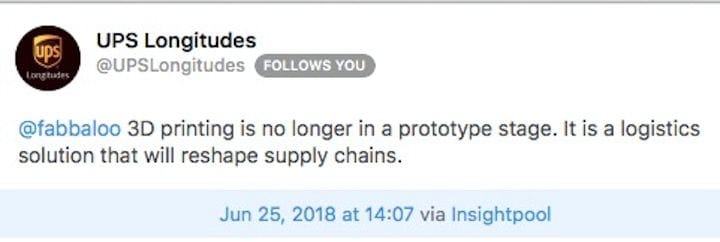
An interesting question was raised regarding the use of 3D printing.
A tweet from follower @UPSLongitudes said:
@fabbaloo 3D printing is no longer in a prototype stage. It is a logistics solution that will reshape supply chains.
UPS Longitudes, by the way, is UPS’s official corporate blog and social media outlet, so you might expect them to promote their own capabilities. But the question is nevertheless valid.
Most people think of UPS as a delivery service, but in reality they are vastly more complex than that. They provide a wealth of services that can tackle virtually any company logistics problem. According to Google, “Logistics” is defined as:
The detailed coordination of a complex operation involving many people, facilities, or supplies.
Yes, that involves delivering a package to your door, but it also means, for example, designing an efficient system for ensuring spare parts are available in a given remote location within a short time period. Planning for such goals is a challenging process, especially when you consider you want to solve the issue at the lowest possible cost.
I think that’s why UPS has long been involved in 3D printing.
3D printing can, in some cases, short circuit one of the most difficult parts of logistics: transportation. The idea is to 3D print a required item onsite (or at least nearby) and eliminate or strongly reduce the transportation requirement.
To that end the company has been experimenting with 3D print services in many of their outlets. I’m not sure how successful this has been from a retail point of view, but it could be that they’re more successful with a corporate approach.
Imagine an arrangement where they promise to produce 3D printed parts at any of their locations for a worldwide client. It is a monumentally difficult venture to establish a worldwide parts supply chain on one’s own, but instead you might outsource the problem to someone like UPS to do so, and they could achieve that through 3D printing.
However, while this sounds good in concept, there are multiple challenges to overcome.
First, and most importantly, 3D printers cannot currently accurately reproduce arbitrary parts. There are severe constraints on material types and the ability to mix materials. This is consequence of today’s somewhat limited 3D printing technologies. There’s nothing UPS can do about that. The implication is that UPS would be able to produce parts only in certain circumstances and not others.
Secondly, desktop 3D printing has made many think that 3D printing is simply a machine on a desk, much like a photocopier. While that is the case sometimes, it is not true all the time: significant post processing steps are often involved, sometimes greatly exceeding the effort required to simply print the item.
And don’t get me started on 3D metal printing, which often requires millions to set up and operate. If UPS wished to provide distributed 3D metal printing services, they would find it extraordinarily expensive to set up multiple regional 3D metal printing service outlets. Perhaps they’re doing so.
Finally, the parts that would be flowing through such a system would require some type of protection from exposure. The digital files would travel through networks and arrive at remote 3D print locations, and there would be multiple points where the 3D design could theoretically be intercepted and thus lose the intellectual property. UPS would have to organize or acquire some type of secure method for 3D printing, perhaps through a streaming solution.
Back to the question, is 3D Printing a logistics solution? I have to agree with UPS Longitudes in this case, with a proviso that the scope of such a business would be somewhat limited, at least today.
It may be a good idea for UPS to set up such a system now, even though there are limitations, because they could then “ride the wave” as increasingly capable 3D print technologies gradually emerge over coming years.
Finally, while Logistics may be a good use of 3D printing, there are many others, including Prototyping, the first practical use of the technology.
There will be many more.

